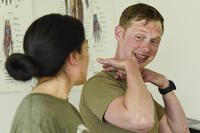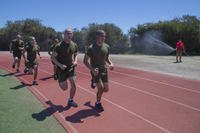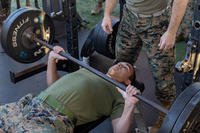Many runners who can run five-minute miles are amazed that their cardio conditioning when swimming is so horrible. It does not make sense to them why someone who was just lapped in the 1.5-mile timed run is lapping them in the 500-meter swim. There is a good reason for that: Running shape is not the same as swimming shape.
Mastering swimming techniques is essential for efficient movement through the water and excelling in military fitness tests. Achieving swimming shape demands dedication and consistency to practice and maintain a pace over any distance. It may be surprising for runners to discover that their cardio conditioning in swimming is not transferred from their running abilities.
Don't underestimate the importance of swimming technique and stamina for excelling in swimming fitness tests used by military special operations units. Like a beginner swimmer, you need to learn the technique and then get into swimming shape, regardless of your athletic history.
While running and swimming require cardiovascular fitness, they use different muscle groups and movement patterns. When you're running, you propel yourself forward with the power of your legs and only swing your arms for balance. In the water, it's all about your arms, core strength and ability to coordinate your movements to glide through the water with minimal resistance. Many runners also kick harder than needed and wind up exhausted in the first minutes of a swim.
So why can you run like the wind but struggle to swim like a fish? It all comes down to technique and conditioning. Running is a natural movement for most people, and even if you're not an elite runner, you can probably manage a decent pace without too much trouble. Swimming is a highly technical skill that often requires a coach to teach you and time to practice to reach a basic level of ability. You must learn to breathe properly, streamline your body in the water, and coordinate your arms and legs to propel yourself forward efficiently.
Another key factor is conditioning. Many runners have weak upper-body muscles, too. In swimming, you must rely on your strength and endurance to maintain a consistent pace. Getting into swimming shape for any non-swimming athlete is not as hard as you may think, and some of the current conditioning helps. It has been proven that once you learn the basics of the stroke and get your 50-meter pace down to your goal pace, you can meet 500-meter timed tests in as little as a month of training. But you have to swim five days a week for at least 30 minutes a day, doing what we call the 50-50 Swim Workout:
Repeat 10 times.
- Swim the 50-meter freestyle fast.
- Swim the 50-meter sidestroke or breaststroke (testing stroke) at pace.
- Rest 10-15 seconds max (but build up to minimal rest over time).
Start this workout with a 500-meter warm-up as you build your endurance. Now you are using the testing distance as your warm-up. This is huge mental and physical progress. One day, when tested, you can tell yourself as your nerves start to flow before a test, "Relax, this is just my warm-up."
With this type of workout and practice discipline, you can significantly enhance your swimming skills and bridge the gap between your running and swimming abilities. The journey will require time and effort, but the results will be worth it. Do not expect to jump in the pool and instantly match your running speed and efficiency unless you grew up swimming on a team. Be patient, listen to and learn from swimmers, adapt to this new discipline and you'll see remarkable progress. You may be able to help them with running as that tends to be a swimmer's weakness.
Running and swimming are required skills in many special operations programs in the military. Push yourself in the pool to become a more well-rounded and effective tactical athlete. Before you know it, you'll be breezing through the water like on land.
As someone who has coached countless land-based athletes in tactical fitness and swimming, I've witnessed firsthand the successes of those fully engaged in developing their weaknesses. I have also seen overconfidence crush people's special ops dreams as they doubled down on their strengths and ignored their weaknesses. But I also know you can transform that weakness into a strength with conditioning, persistence and the right coaching approach. There will be many areas on this training journey where you will fail and must work hard to meet the standard. So keep at it and don't be discouraged by the challenge; embrace it.
Now that you are on your way to learning how to swim, the next challenge for running and swimming athletes is building your body to handle the loads of equipment carry, rucking, boats and logs, and fireman carries. Assessing and addressing weaknesses, no matter how long it takes, is the way to be thoroughly prepared for the special journey of the tactical athlete serving in the military.
Want to Learn More About Military Life?
Whether you're thinking of joining the military, looking for fitness and basic training tips, or keeping up with military life and benefits, Military.com has you covered. Subscribe to Military.com to have military news, updates and resources delivered directly to your inbox.


















